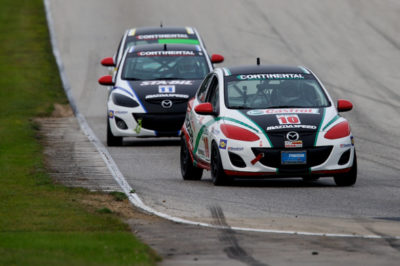Glenn Bocchino owns a brake pad company, Cobalt Friction. He also owns, and drives for, i-Moto Racing, which campaigns a fleet of MAZDASPEED3s in the Grand-Am Continental Tire Sports Car Street Tuner series. Those three roles make him rather uniquely qualified to discuss brake issues and, even if he is a little biased (excuse the brake-related pun) on which pads are the best to run on a racecar, the science behind it applies to whatever pads a driver or team might choose.
“Brake pads evolve over time,” he says. “There are so many different pads and how they’re manufactured, how they wear, the torque levels, the feel, the release of the pedal and so on…. For our application we go with a medium- to high-torque brake pad with a greater amount of endurance. We can put a very high-torque brake pad on the car, but it’s not necessarily going to work and the drivers may not like it. Some drivers want less torque because they want to squeeze the pedal, and some guys may just want to touch it – like on formula cars, it just stops.”
There are always trade-offs, he explains. Endurance compounds have less torque – they are less aggressive and a driver has to push a little harder and brake a little earlier to get the same speed on corner entry. The endurance pads give up torque for longevity.
The other issue in choosing brake pads is balance. While the easy choice is to run the same pads all the way around, it may not be the fastest or most comfortable choice.
“What we’ve found works is a medium- to high-torque front pad and a very liner, low-torque rear pad,” Bocchino explains.“ When you look at a brake dyno chart, it goes up, it ramps up as you push the pedal, then it kind of falls out – the torque of the pad gets less. It goes up for initial bite, then it starts to decline or goes very slightly up.
“The rear pad is very linear, because we don’t want to get into ABS prematurely. If you have too aggressive a rear pad, it’ll kick the car into ABS. The goal is to balance the car with the compounds and get it to the optimum brake performance before you get into ABS. That’s why we stagger the compounds, because with a front-drive car, all the weight is at the front and there is so much more weight on the front axles than there is on the rear.”
A car like an MX-5, he says, may need less balancing than the MAZDASPEED3 because of the much more equal weight balance front to rear on the rear-wheel drive car.


 ACCESSIBILITY
ACCESSIBILITY